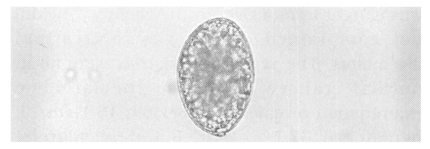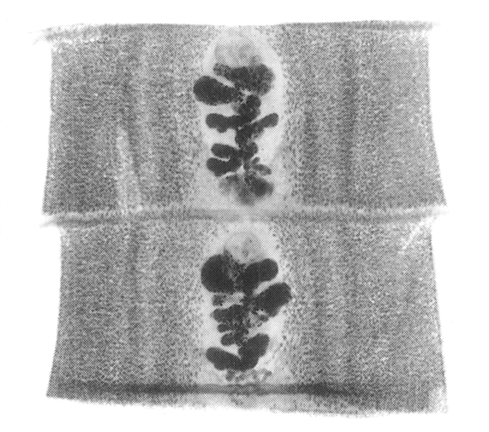The cestode infections occur not frequently, but often cause serious clinical problems. According to the annual reports of a medical institute located in Seoul, the egg positive rate of overall helminths and Diphyllobothrium latum was 6.5% and 0.004%, respectively (Lee et al., 1994). The second Intermediate hosts were suggested as redlip mullets (Liza haematocheila), trouts, and certain marine fish in Korea (Joo et al, 1983; Lee et al., 1987; Lee et al., 1989; Lee et al., 1994; Sohn et al., 1996; Chung et al., 1997). We are adding two more human cases of fish tapeworm infection after ingestion of raw salmon flesh.
Case 1: A 7-year-old girl visited out-patient clinic on July 27, 2000, due to spontaneous discharge with the chain of segments which was 42 cm in length (Fig, 1). She had no history of eating raw fish except once when she ate raw salmon flesh all together with her parent and sister in January, 2000, in Sockcho-shi, Kangwon-do, Korea. The salmon was caught from a river in the vicinity. She did not complained of any gastrointestinal discomfort. The serum chemistries were all in normal ranges and the hematologic examination revealed; hemoglobin 13.1 gm/dl, hemotocrit 37.5%, WBC 8.400/µl, platelet 3,400 × 103/dl, MCV 85.9 fl, MCH 29.9 pg, total eosinophil count 200/µl. The coprological study was positive for D. latum eggs (Fig. 2). The worm was identified as D. latum, based on the biological characters: external morphologies, coiling of uterus, number of uterine loops, position of genital opening, mor-phologies of cirrus, cirrus sac and seminal vesicle, position of vagina and uterine pore (Fig. 3). A single dose of praziquantel 400 mg was given but stool examination was still positive a week later. Another dose of 600 mg was given to and the young female patient was found to be free from the egg after one month.
Case 2: Two months after the young girl's visit, her mother discharged a similar tape worm segments as her daughter did. She was not able to visit our hospital because most Korean medical doctors were on strike against new medical care policy. She medicated herself with one tablet of praziquantel (600 mg) purchased from a drug store without doctor's prescription, eventhough it is illegal. She visited our clinic three month later on December 14, 2000. Every family member was included for the stool examination this time but the result was negative for diphyllobothriid eggs.
Several species have been found to infect humans and the mains are D. latum, D. pacificum and D. nihonkaiense. D. latum is known to distribute Siberia, north America and Japan. D. pacificum distributes in south America and D. nihonkaiense in Japan. D. latum is the longest of the tapeworms that infect human, measuring 4 to 15 m in length and 10 to 20 mm in width. Other Diphyllobothrium species are smaller, rarely more than 1 m long. D. latum is creamy white in color and consists of 3,000 to 4,000 proglottids. The scolex is shaped like a spoon and has a pair of groove, or bothria, in its anterior portion that serve as an organ of attachment. Comparing the difference of D. latum and D. nihonkaiense, the latter has slant penoscrotal and different DNA base sequence (AB015755D vs AF096240). D. latum is transmitted to humans through eating raw or uncooked fish (Salminen, 1970). Although many carriers are asymptomatic, clinical manifestations of diphyllobothriasis may include diarrhea, epigastric pain, nausea and vomiting.
We have two types of salmon, Oncorhynchus keta and O. masou. There is no epidemiological study for D. latum infection in the second intermediate hosts in Korea. The infection rate in Korea is assumed to be close to that of Japan because the two countries are sharing the same seas and the same second intermediate hosts. A Japanese report from 1977 to 1982 showed 15.9% to 48.4% infection (Oshima and Wakai, 1983) in the cherry salmon (Oncorhynchus masou). At circumpolar north region, D. latum was rarely found in salmonids but in pikes and perches (Curtis and Bylund, 1991).
In Korea, the artificial hatchery and stocking human-bred salmons were started in 1913 at Kowon, Hamgyongnam-do. In 1967, an institute for the cold water fish was established in Kangwon-do. The returning rate of the salmon was 0.3% at first, but now it has increased up to 1.5%. The number of stocks and the recovery units were 8,000 and 410 in 1970 and 1.45 million and 27,000 in 1998, respectively. The amount of salmon catch was 553 tons in 1997 and is still increasing through the expanded stocking.
Therefore, it is our expectation that the infection rate of D. latum in humans would be increasing in near future with the exploding consumption of salmon in Korea. For the successful control of this parasite, epidemiological studies of D. latum infection should be carried out followed by thorough investigations to find out relevant ways to prevent the further spread of this infection.









